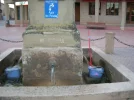It is interesting the we (collectively) are avoiding a level of self reflection, and seem to be ignoring those who have suggested other explanations that don't blame the food and water.
We may not be able to tell what caused
@Vanozza or anyone else's GI issues. What we have established, though, is that it is almost definitely not for the reason originally stated - raw milk. It is also extremely unlikely to have been tap water, and pretty unlikely to have been food served and consumed in a restaurant or bar.
So what is left? Quite simply, us and our observance or lack thereof of good food and personal hygiene practices.
- If you buy a bocadillo in the morning to eat for lunch, not doing something to sanitize your hands before you remove it from its wrapping puts you at increased risk.
- If you buy a salami from the cold section of a supermercado rather than find one hanging un-refrigerated from a rack in the deli, and leave it it your pack for a day or so, you are taking a greater risk.
- If you choose a soft cheese because they are just so yummy, and keep a bit for Ron, that is also going to be a greater risk than choosing one of the many, almost equally delicious, hard cheeses.
- Each time you go into a toilet, and only give your hands a cursory rinse, you are more likely to be carrying a pathogen, and the same is true when you don't wash your hands before you have any meal or handle food in a kitchen.
I see all of these practices both in day-to-day life and saw them regularly on the Camino. I took some of these risks myself, And I knew that if I did have an upset stomach or loose bowel,
I needed to be more careful.
I was far more likely to be the cause of my own problems than anything else.
As for collecting and consuming ground water without any treatment, I once would have thought that no reasonable person would have ever contemplated that. If you are inclined to heed the advice of those who say you only need to carry a couple of 500ml bottles, consider carrying one of the readily available water treatment tablets. A slide of 25 Micropur Forte tablets can treat 25 litres of water, and in a small ziploc bag weighs less than 10 g. In 30 minutes, you will have water treated for bacteria and viruses (but not giardia, which requires two hours of contact for treatment).


























